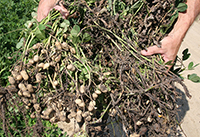Plant diseases, like leaf spot and white mold, are forcing Georgia peanut farmers to consider moving their harvest times up a few days, according to University of Georgia Cooperative Extension peanut agronomist Scott Monfort.
“We’re trying to make sure that everybody gets out in their fields to check the maturity of each individual field and adjusts their harvest plans based on these problems that we’re finding,” Monfort said.
A combination of rainy weather, persistent cloudiness and farmers’ inability to get into fields and apply fungicides this summer led to the perfect condition for many diseases.
“We have isolated areas where disease has gotten away from some farmers due to the weather. It looks like we’re going to be digging peanuts a little bit early to make sure we don’t lose too much of our crop there,” Monfort said. “That’s going to hurt a little bit on yield potential and grade.”
Almost all varieties of peanuts grown in Georgia, including Georgia’s most commonly produced variety — Georgia-06G, are somewhat susceptible to leaf spot. Leaf spot causes the peanut plant’s leaves to wither, turn yellow and fall off. It can also form lesions on the stem and other parts of the plant.
Among diseases, white mold is one of top causes of peanut yield loss every year. When growers fail to use proper crop rotations, their peanuts are more at risk of the disease. If farmers consistently grow peanuts behind peanuts in the same field, their crop is at a higher risk of white mold disease. Sclerotium rolfsii, the causal agent of white mold, is a fungus that stays in the soil between cropping systems.
“Rain, being behind on our fungicide programs, having shorter rotations in some areas of the state — it is all finally catching up with us,” Monfort said.
He estimates Georgia will produce 658,000 acres of peanuts this year, a significant decrease from the 828,000 acres produced last year. Three straight weeks of rainfall in late May and an increased commodity price for cotton led growers to switch from growing peanuts to growing cotton.
“We had, on average, about a 30 percent decline in peanut acres this time compared to last year," Monfort said. “It probably would have been more like 20 percent if it wouldn’t have been for the cotton prices reaching 90 cents and the rainy weather conditions that kept our growers from planting their full crop. But I think that actually is going to help us. We needed to come down in acreage some and get this rotation thing under control.”
Monfort expects some farmers who planted in early April to start digging their crop this week. Producers who didn’t switch to cotton and instead planted a late crop — between May 25 and June 15 — still have approximately two more months of growing season. Monfort estimates this to be about 35 percent of the total crop.
Monfort and the rest of the UGA Peanut Team will discuss issues related to this year’s crop during the 32nd annual Georgia Peanut Tour, set for Sept. 18-20. The tour will be held in the Savannah, Georgia, area. Register for the tour at georgiapeanuttour.com/.
For more information about peanuts, see peanuts.caes.uga.edu.







